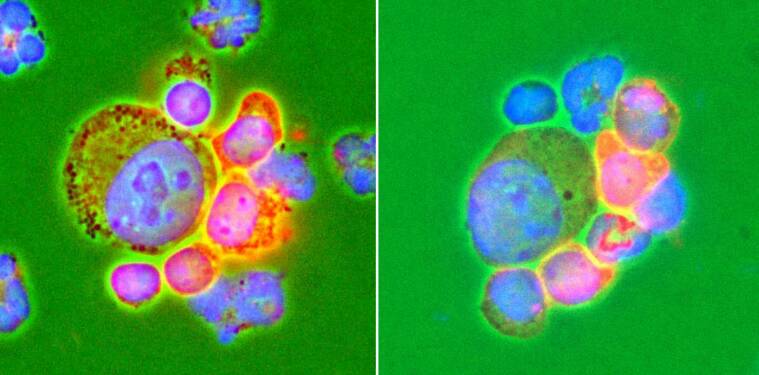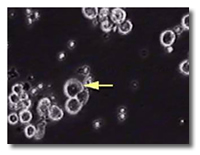Occasional, though rare, cases of spontaneous regression in human cancers have been seen and documented in the past, but no satisfactory explanations for this phenomenon have ever been put forward. UNTIL NOW...
While conducting a series of experiments with mouse sarcoma 180 (S180) cells, which form highly aggressive cancers in all normal mice, Dr. Cui and his colleagues happened upon a single mouse that surprised them with its ability to resist several forms of cancer, despite repeated injections of the sarcoma cells.
Breeding the mouse produced offspring that also exhibited cancer resistance, suggesting a likely genetic link.
Further experiments showed that in these cases it was a massive infiltration of white blood cells that destroyed cancer cells in these mice without damaging normal, healthy cells. Based on these results, Drs. Cui and Willingham and their colleagues suggested that a previously unknown immune response may be responsible for spontaneous regression.
Previous Studies in Humans
Given the surprising results of their mouse studies, they set out to find similar CKA in the white cells of healthy humans. They tested blood from a large number of people and found that humans do indeed have CKA similar to the cancer resistant mice. In humans, however, CKA levels vary more between individuals; this variability may explain why some develop cancer and others do not.
In order to determine whether CKA levels are associated with cancer, they evaluated the CKA from people who were either healthy or had already been diagnosed with cancer. People with cancer had lower CKA levels than healthy people in a similar age group.
The types of leukocytes that displayed the highest level of CKA were the granulocytes and monocytes, which is very similar to what we found in the cancer resistant mice. Interestingly, the CKA was lower in older subjects, during
winter months or in times of stress.
Granulocyte transfusions and other cell therapies
Granulocytes are the most abundant white blood cells in humans and are part of the body’s first line of immunological defense. These cells can be collected from healthy donors and transfused to fight infections in patients with severe deficiency of granulocytes. This is an established procedure that has been in use for more than 40 years with very good safety records.
GIFT is significantly different from other cell therapies that have used either the patient's own cells or a different type of donor cells, such as T-lymphocytes. This is the first time that donors will be selected according to a very relevant activity: the ability to kill cancer cells.
Publications and Related Press Coverage
NewScientist.com: 'Cancer-resistant' people lend out their killer cells
The London Telegraph: Cancer cure may be available in two years
Academic Publications:
Hicks AM, Riedlinger G, Willingham MC, Alexander-Miller MA, Von Kap-Herr C, Pettenati MJ, Sanders AM, Weir HM, Du W, Kim J, Simpson AJG, Old LG, Cui Z. Transferable anticancer innate immunity in spontaneous regression/complete resistance mice. PNAS E-published May 8, 2006.
Abstract:
Spontaneous regression/complete resistance (SR/CR) mice resist very high doses of cancer cells that are lethal to WT mice even at low doses. In this study, we show that this resistance is mediated by rapid infiltration of leukocytes, mostly of innate immunity, in both primary and repeated challenges. Formation of rosettes with infiltrating natural killer cells, neutrophils, and macrophages was required for the subsequent destruction of cancer cells through rapid cytolysis. Highly purified natural killer cells, macrophages, and neutrophils from the SR/CR mice independently killed cancer cells in vitro. The independent killing activity by each subset of effector cells is consistent with the observation that the resistance was abolished by depleting total infiltrating leukocytes but not by depleting only one or two subsets of leukocytes. The resistance was completely transferable to WT recipient mice through SR/CR splenocytes, bone marrow cells, or enriched peritoneal macrophages, either for prevention against subsequent cancer challenges or eradication of established malignancy at distant sites.
A June, 2004, article by Dr. Cui and Dr. Willingham, "The effect of aging on cellular immunity against cancer in SR/CR mice," published in the journal Cancer Immunology, Immunotherapy.
Dr. Cui wrote an essay, "The winding road to the discovery of the SR/CR mice" for the journal Cancer Immunity, published by the Academy of Cancer Immunology in October, 2003.
The first major scientific publication based on this research was published in the journal Proceedings of the National Acadamy of Sciences:
Cui Z, Willingham MC, Hicks AM, Alexander-Miller MA, Howard TD, Hawkins GA, Miller MS, Weir HM, Du W, DeLong CJ. Spontaneous regression of advanced cancer: identification of a unique genetically determined, age-dependent trait in mice. Proc Natl Acad Sci U S A. 2003 May 27;100(11):6682-7.
Abstract:
We have established and studied a colony of mice with a unique trait of host resistance to both ascites and solid cancers induced by transplantable cells. One dramatic manifestation of this trait is age-dependent spontaneous regression of advanced cancers. This powerful resistance segregates as a single-locus dominant trait, is independent of tumor burden, and is effective against cell lines from multiple types of cancer. During spontaneous regression or immediately after exposure, cancer cells provoke a massive infiltration of host leukocytes, which form aggregates and rosettes with tumor cells. The cytolytic destruction of cancer cells by innate leukocytes is rapid and specific without apparent damage to normal cells. The mice are healthy and cancer-free and have a normal life span. These observations suggest a previously unrecognized mechanism of immune surveillance, which may have potential for therapy or prevention of cancer.
Related Articles and Press Coverage:
Discover Magazine; August, 2006
Scientific American; May 9, 2006
New York Times; May 9, 2006
Winston-Salem Journal; May 9, 2006 (Free Registration Required)
Newsday.com; May 9, 2006


Research







